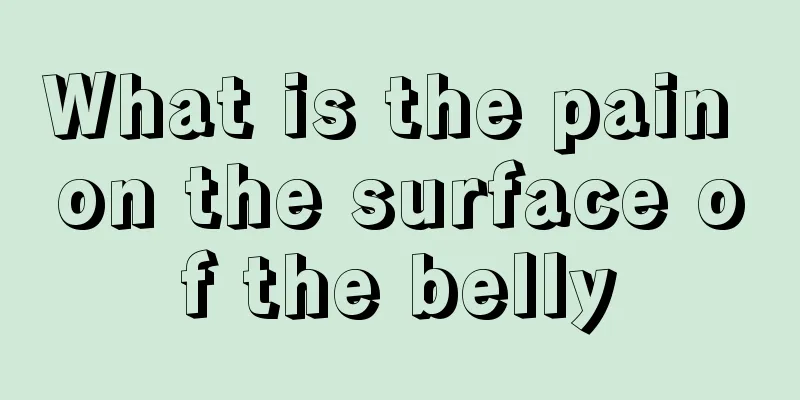What is the pain on the surface of the belly

|
Sometimes people will feel pain on the surface of their abdomen. In this case, they need to pay special attention to their medical condition. If these conditions occur, they should go to the hospital for a detailed examination. These regular examinations are definitely good for their body and can effectively avoid them. Moreover, the causes of each person's illness are completely different. If it is acute abdominal pain, the treatment method may need to be more complicated. Causes 1. Acute abdominal pain (1) Diseases of abdominal organs 1) Acute inflammation of abdominal organs: acute gastroenteritis, acute corrosive gastritis, acute cholecystitis, acute pancreatitis, acute appendicitis, acute cholangitis, etc. 2) Perforation or rupture of abdominal organs: perforation of gastric and duodenal ulcers, perforation of typhoid intestinal organs, rupture of liver, rupture of spleen, rupture of kidney, rupture of ectopic pregnancy, rupture of ovary, etc. 3) Obstruction or expansion of abdominal organs: gastric mucosal prolapse, acute intestinal obstruction, inguinal hernia, intussusception, biliary ascariasis, cholelithiasis, kidney and ureteral stones, etc. 4) Torsion of abdominal organs: acute gastric torsion, ovarian cyst pedicle torsion, omentum torsion, intestinal torsion, etc. 5) Intra-abdominal vascular obstruction: acute obstruction of the mesenteric artery, acute portal vein thrombosis, dissecting abdominal aortic aneurysm, etc. (2) Abdominal wall diseases: abdominal wall contusion, abdominal wall abscess and abdominal wall herpes zoster, etc. (3) Chest diseases: acute myocardial infarction, acute pericarditis, angina pectoris, pneumonia and pulmonary infarction, etc. (4) Systemic diseases and others: rheumatic fever, uremia, acute lead poisoning, porphyria, abdominal allergic purpura, abdominal epilepsy, etc. 2. Causes of chronic abdominal pain Diseases of abdominal organs: (1) Chronic inflammation: reflux esophagitis, chronic gastritis, chronic cholecystitis, chronic pancreatitis, tuberculous peritonitis, inflammatory bowel disease, etc. (2) Gastrointestinal diseases: gastric and duodenal ulcers and gastrinoma, etc. (3) Torsion or obstruction of abdominal organs: chronic gastrointestinal torsion, intestinal adhesions, omental adhesion syndrome, etc. (4) Increased capsular tension: liver congestion, hepatitis, liver abscess, liver cancer, splenomegaly, etc. (5) Gastrointestinal motility disorders: gastroparesis, functional dyspepsia, hepatic flexure and splenic flexure syndrome. The nature of abdominal pain is related to the organ where the lesion is located and the nature of the lesion. For example, colic often indicates obstruction of hollow organs; bloating and pain are often caused by increased tension in the visceral capsule, traction of the mesentery, or flatulence and expansion of hollow organs. The degree of pain is sometimes consistent with the severity of the lesion, but due to individual differences, sometimes the degree of pain does not reflect the extent of the lesion. |
<<: What to do if I have stomach bloating and pain after eating too much
>>: What's the matter with the dull pain around the belly button
Recommend
Effects and functions of mulberry soaked in liquor
Mulberry is a relatively common fruit. It has a g...
Will men's buttocks be lifted when they do squats
The process of squatting helps to mobilize the wa...
What are some good acne treatments
Acne removal is the process of eliminating acne u...
What are the symptoms of ovarian tumors
Symptoms of ovarian tumors may include abdominal ...
Why does my waist hurt when I walk
Back pain when walking is a problem that many peo...
Symptoms of angina pectoris, these typical characteristics should be known
Angina pectoris is caused by myocardial ischemia....
What are the causes of liver cancer? What are the benefits of drinking yogurt for liver cancer patients?
According to statistics, about 70% to 80% of live...
What is the basis for glioma diagnosis
Glioma is a malignant tumor of the brain. So, wha...
The best concealer liquid foundation
Liquid foundation for concealing blemishes is a k...
There are 5 ways to treat stomach problems
Gastric disease is a relatively common disease am...
What is parotid gland tumor and what are the symptoms
The occurrence of parotid gland tumor is not scar...
Most bladder cancer patients will have hematuria
Most cases of bladder cancer will cause hematuria...
What is body fat in the human body
Some obese people will find out that they have fa...
What are the symptoms of lung cancer? Experts teach you how to identify the symptoms of lung cancer
Lung cancer is a cunning disease, and some of its...
What are the sequelae of ankle comminuted fracture
Comminuted fracture is a relatively serious type ...









